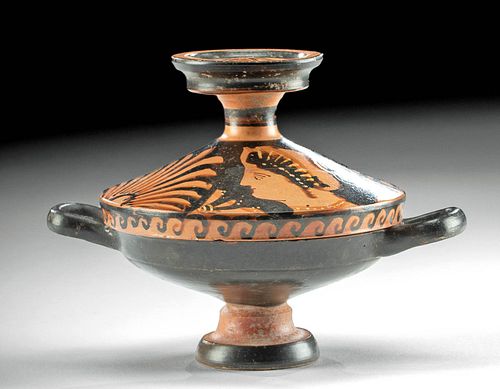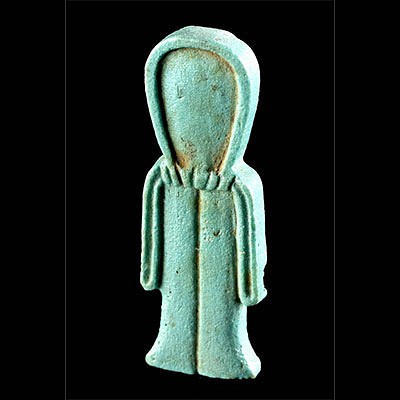Apulian Red Figure Lidded Lekanis w/ Ladies of Fashion
Lot 14b
About Seller
Artemis Fine Arts
686 S Taylor Ave, Ste 106
Louisville, CO 80027
United States
Selling antiquities, ancient and ethnographic art online since 1993, Artemis Gallery specializes in Classical Antiquities (Egyptian, Greek, Roman, Near Eastern), Asian, Pre-Columbian, African / Tribal / Oceanographic art. Our extensive inventory includes pottery, stone, metal, wood, glass and textil...Read more
Categories
Estimate:
$1,400 - $2,100
Absentee vs Live bid
Two ways to bid:
- Leave a max absentee bid and the platform will bid on your behalf up to your maximum bid during the live auction.
- Bid live during the auction and your bids will be submitted real-time to the auctioneer.
Bid Increments
| Price | Bid Increment |
|---|---|
| $0 | $25 |
| $300 | $50 |
| $1,000 | $100 |
| $2,000 | $250 |
| $5,000 | $500 |
| $10,000 | $1,000 |
| $20,000 | $2,500 |
| $50,000 | $5,000 |
| $100,000 | $10,000 |
| $200,000 | $20,000 |
About Auction
By Artemis Fine Arts
Nov 4, 2021
Set Reminder
2021-11-04 10:00:00
2021-11-04 10:00:00
America/New_York
Bidsquare
Bidsquare : Ancient & Ethnographic Art Through The Ages
https://www.bidsquare.com/auctions/artemis-gallery/ancient-ethnographic-art-through-the-ages-7799
Ancient art from Egypt, Greece, Italy and the Near East, as well as Asian, Fossils, Pre-Columbian, Native American, African / Tribal / Oceanic, Fine art, and much more! All categories, all price ranges... all legally acquired and guaranteed to be as described or your money back. Artemis Fine Arts info@artemisgallery.com
Ancient art from Egypt, Greece, Italy and the Near East, as well as Asian, Fossils, Pre-Columbian, Native American, African / Tribal / Oceanic, Fine art, and much more! All categories, all price ranges... all legally acquired and guaranteed to be as described or your money back. Artemis Fine Arts info@artemisgallery.com
- Lot Description
Magna Graecia, Southern Italy, Apulia, ca. 340 to 325 BCE. A fine wheel-thrown lekanis with a shallow basin, pedestal foot, and lid beautifully decorated via the red-figure technique with 2 Ladies of Fashion, each adorned with fugitive white pigment creating elegant ornamentation. The lovely ladies are each dressed in a beaded saccos over an upswept coiffure and a beaded necklace. These ancient visages are separated by stylized palmettes. A cresting wave motif additionally adorns the outer periphery of the rim, meeting the black-painted body below. Twin applied loop handles protrude from either side of the raised bowl. The large knob atop the lid features a nested chevron pattern on its depression, and the vessel sits upon a concave, tiered foot. Size: 5.1" in diameter x 3.9" H (13 cm x 9.9 cm)
Lidded lekanides were cosmetic containers, often given by fathers to brides on their wedding day. Interestingly, the lady of fashion motif complements this, as scholars believe they represented young women on their wedding day.
Provenance: private New York, New York, USA collection; ex-private T.G. collection, Williston, Florida, USA, #2022, acquired in 1999; ex-Ancient World Arts, Bantam, Connecticut, USA; ex-Arte Primitivo, New York, USA
All items legal to buy/sell under U.S. Statute covering cultural patrimony Code 2600, CHAPTER 14, and are guaranteed to be as described or your money back.
A Certificate of Authenticity will accompany all winning bids.
PLEASE NOTE: Due to recent increases of shipments being seized by Australian & German customs (even for items with pre-UNESCO provenance), we will no longer ship most antiquities and ancient Chinese art to Australia & Germany. For categories of items that are acceptable to ship to Australia or Germany, please contact us directly or work with your local customs brokerage firm.
Display stands not described as included/custom in the item description are for photography purposes only and will not be included with the item upon shipping.
#168066Lid and base are both ancient, but not originally created together. Collection labels on base and foot. Lid repaired from 2 pieces with break lines visible. Base repaired from at least 3 pieces with restoration over break lines. Chips to rim of base and lid. Expected nicks and abrasions throughout. Otherwise, excellent with impressive remaining pigments.Condition
- Shipping Info
-
All shipping is handled in-house for your convenience. Your invoice from Artemis Gallery will include shipping calculation instructions. If in doubt, please inquire BEFORE bidding for estimated shipping costs for individual items.
-
- Buyer's Premium



 EUR
EUR CAD
CAD AUD
AUD GBP
GBP MXN
MXN HKD
HKD CNY
CNY MYR
MYR SEK
SEK SGD
SGD CHF
CHF THB
THB














